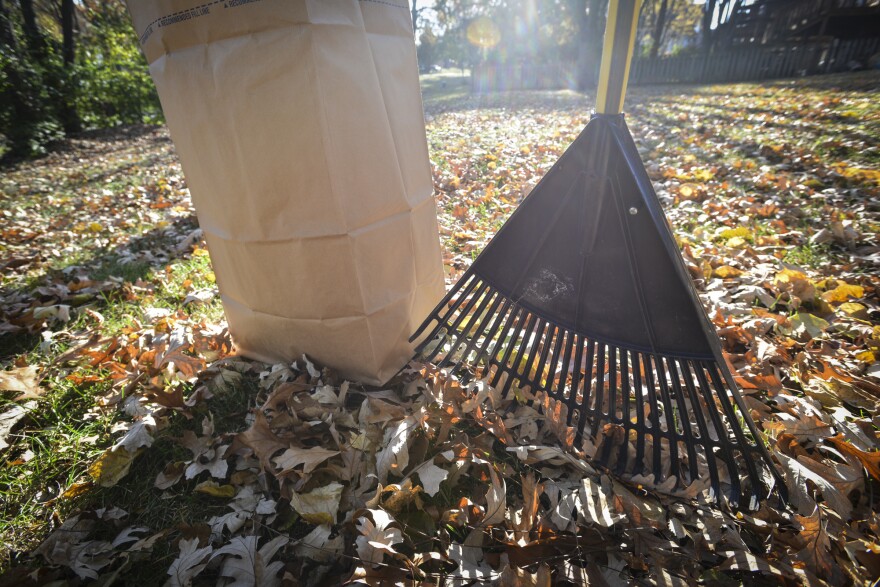Alicia Ramsey was outside her home doing yard work when she noticed something in the fallen leaves: the chrysalis of a butterfly.
Ramsey, who’s a watershed ecologist with the San Antonio River Authority in Texas, said it felt like a rare moment, but fallen leaves are teeming with animals that depend on them.
“We just don't realize what's in our leaves,” Ramsey said. “People throw out their leaves, or they compost their leaves, or they mulch their leaves, not realizing how much life is actually in them.”
While it feels like common practice to rake leaves and remove them from lawns, there’s a growing movement of people like Ramsey who are treating leaves more like essential habitat for local species rather than a waste product.
To “leave the leaves” is simply allowing leaves to break down naturally over the winter. Scientists and advocates say it can be a way to help improve soil health and support wildlife populations.
Researchers at the University of Maryland have found that significantly more insects and other invertebrates emerged in the spring from lawns that retained fallen leaves over the winter. The study is one of the first to look at the importance of leaves for aboveground insects like moths, butterflies and beetles.
Karin Burghardt, one of the study’s authors, views fallen leaves as an opportunity to create habitat, especially in suburban areas where humans have changed the landscape so significantly.
"If we can create more functional spaces in these suburbs, then those are areas where we could potentially support insects,” she said.
She said many of these insect populations are in rapid decline, but they play important roles, like pollinating plants and eating pests.

Leaving fallen leaves on the ground also allows nutrients, like carbon, to return to the soil and the surrounding plants, said Ryan Pankau, a horticulture educator with the University of Illinois Extension. His background is in forestry, so he understands fall leaves through that lens.
“What I see in those leaves is an almost perfect recycling system that exists within a forest,” Pankau said. “Those leaves represent the nutrient exchange that's happening in that forest.”
Trees expend a lot of energy in the spring to produce leaves, he explained. While they do pull back much of the nutrients—including chlorophyll, the 'green' in leaves that aid in photosynthesis—they benefit from the leaves naturally decomposing around their trunks.
Pankau said that without those leaves, conditions become less favorable for trees, and it can be especially detrimental in urban and suburban areas, where raking is common.
"We know we don't have as great of a soil microbial community, so we need all these components in place to keep that healthy,” Pankau said.
When these cycles and communities are disrupted, it can leave a lasting impact on soils, Burghardt said. Her lab at the University of Maryland also found that there are lower levels of carbon and organic matter in yard soil where leaves have been historically removed, which can have consequences.
"Those soils are going to be a lot worse at absorbing water, so they're not going to be as good at storm water management and preventing flooding from taking place,” she said. “They also aren't hosting as robust microbial communities that can help the rest of our plants grow well.”
Lindsey Kerr, a consumer horticulture educator at Michigan State University Extension, has been fielding more questions recently from people who want to learn more about leaving their leaves this fall.
She said she’s heard concerns about whether the leaves will kill lawns and harm plants in gardens. But she said that’s not the case.
“There's a lot of ignorance, I think, about lawns,” she said.” People have been doing what their parents were doing, and they've doing what their parents were doing.”
Kerr said that leaves don’t have to stay right where they fall. They can be raked into garden beds to help insulate plants as the weather gets colder or tucked around the bases of trees to use as mulch.
"I have so many uses for leaves in my yard that I don’t have enough,” she said.
She emphasized that leaves should not be raked into the road or taken to the dump.
This story was produced in partnership with Harvest Public Media, a collaboration of public media newsrooms in the Midwest and Great Plains. It reports on food systems, agriculture and rural issues.




